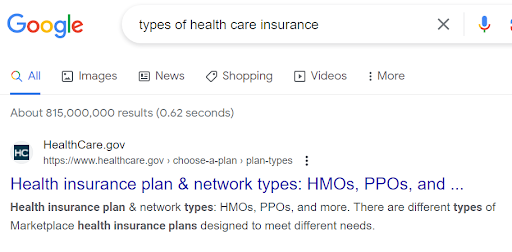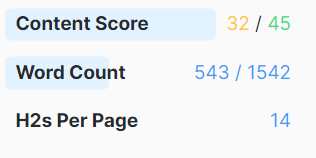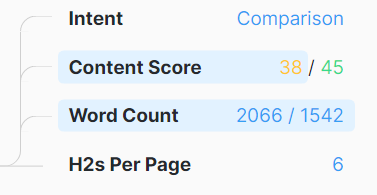Things at your health insurance company are … fine, you suppose. You have a sizeable lineup of clients. You can’t please everyone, so some leave before more inevitably come in to replace them. Your team designed a website, but you have to admit it’s not getting as many visitors as you’d like.
Your team of leaders explains to you that health insurance companies like yours need to do more to get noticed. You need a presence on the internet and on social media. You need a content marketing agency.
As you look out your office window, hands folded behind your back, you ever-so-slightly turn your head.
“Get Brafton on the phone.”
The Importance of Content Marketing for Today’s Health Insurers
If you want to get your business known online, digital marketing is virtually a must. So what is it, and why should health insurers give it the time of day?
Content marketing is a form of digital marketing and an indirect form of advertising. Instead of using radio jingles or TV spots, it generates interest in your business by taking advantage of various styles of marketing while always keeping search engine optimization (SEO) in mind.
Let’s look at some common types of content marketing your health insurance company can use:
Blogs
Blogs could be called the bread-and-butter of content marketing. These are often educational in nature, explaining a relevant subject before wrapping it up with a call to action (CTA). The goal here is to make your brand an authority on subjects relevant to your field. Put out enough interesting blogs and you’re on your way to being relied upon for information, which in turn boosts your brand recognition. Above all, it gets people to trust you.
Blogs for your company might include information about the different types of health insurance and which one is best for whom. They might be about how to do desk yoga if you’re after the work-from-home types. Maybe they can lay out options for senior health care insurance. Really, anything is in play as long as it’s at least tangentially related to your brand. No need to pigeonhole yourself — whatever you want to be seen as an authority in, go for it (and don’t be afraid to get creative).
Blogs work in part because nothing turns off a reader like a sales pitch mingling with their search for unbiased information. People are naturally averse to advertising, so earning their trust without sounding like an ad can ultimately be what gets them to convert to your brand.
Subscribe to
The Content Marketer
Get weekly insights, advice and opinions about all things digital marketing.
Thank you for subscribing to The Content Marketer!
Landing Pages
A landing page directly markets a product or service, laying out all its features, benefits and reasons why you should use it. Landing pages are often to-the-point and don’t preamble much before launching into the heart of things. In contrast to blogs, they’re not really educational as much as promotional.
White Papers
If you want to explain something in great detail, you may want to write a white paper. These are often for B2B purposes after a client has already shown interest in a product or service. Their purpose is to go way deep into how it works and why you should invest in it. As you might expect, white papers can be quite lengthy, with many being thousands or even tens of thousands of words.
eBooks
The term “eBook” means something a little bit different in digital marketing than it does for your J.R.R. Tolkien collection. It’s still an electronic book, but marketing eBooks can include a number of topics about their products. For example, you might explain how your product or service solves a specific problem. eBooks are often, though not always, visual-heavy, with lots of infographics, charts and attractive page designs. They’re normally long-form, though not as much as white papers.
Social Media
Social media is a place to catch your target audience’s attention and lead them to another piece of content, like a blog or landing page. Really talented social media specialists know how to get someone to take a break scrolling through their feed long enough to see the post, become interested and stop what they’re doing to click the provided link.
These are just some of the different types of content marketing you can use to get people enrolling in your plans.
Content Marketing Strategies All Share a Few Common Goals
The intricacies of one health insurance marketing strategy can differ from the next, but they all have a few things in common. With a well-planned and executed strategy, you can:
- Increase brand recognition. The first step in a good content marketing strategy is to get your name out there and in people’s heads.
- Earn more potential customers. The end goal is to bring in business.
- Keep your existing patients. Even if you bring in new patients, it’s not much good if they don’t stay.
- Improve patient experiences. Patients will feel more appreciated if you engage with them.
What’s SEO?
Earlier, we used the term search engine optimization (SEO). Content marketing agencies that write blogs and landing pages are very into SEO, for a pretty simple reason: It makes your pages more visible on search engine result pages (SERPs).
Just think about how people looking for a health care insurance agency go about it. Many go straight to search engines like Google with queries like, “What’s the best health care insurance?” and “What are the different types of health care insurance?”
As soon as they hit the Enter key, the effects of SEO happen to determine which results show up at the top of the page. The most relevant pages with the best SEO are at the top.
It’s the job of the content marketing agency to put you there.
The Anatomy of a Great Piece of Health Insurance Content
Let’s talk about what a great piece of health insurance content looks like, starting with a blog.
First, you and the content marketers come up with a plan. This includes answering questions like:
What Are Our Goals With This Piece?
Nothing can get done without first establishing goals. Another way of phrasing this is, “What do we want to accomplish with this piece of content?”
We said before that the purpose of blogs is generally to boost brand authority with educational content, so let’s say that’s what you want to do.
If you have another goal, such as “Offer the target audience reasons why they should enroll,” then you’d probably be making a landing page instead.
What Should the Blog Be About?
Following your goal, your blog should be about something relevant to the health care insurance industry. That’s a pretty broad field, so your options are many. You can determine the answer to this question by phrasing it more specifically: “What do we want to be seen as a leading authority in?” The answer could be something general like health care insurance, but that probably wouldn’t make for a very effective blog. Instead, it’s best to diversify and cover all the topics that make up health care insurance marketing.
For the sake of argument, let’s say the topic you decide on is “The different types of health care insurance.”
What Keyword Do We Want To Rank For?
Now that you have a topic, we can tweak it a bit depending on the keyword we’re aiming for. Keywords and keyphrases are the words someone types into the search bar looking for answers.
This is when the content marketing agency gets the SEO keyword research team involved. In a nutshell, their job is to find a relevant keyword that’s reasonably easy to rank for. Let’s type “types of health care insurance” into Google and see what comes up.

A “.gov” page is ranked No. 1 here. Government webpages are very difficult to outrank, even though they may not be especially optimized. This is because they’re generally regarded as authoritative sources. In fact, at the time of this writing, the SEO tool MarketMuse says it’s only got a content score of 32 out of a target of 45.

Well, there’s nothing we can do about that — but that doesn’t mean everyone’s going to click that link or stop there. How about the No. 2 spot? It looks like it’s WebMD with a blog that compares the different types of health care insurance. It’s optimized reasonably well, but not perfectly.

We’re starting to get a look at what we’re competing against as we go down the list of results. While we’re up against some stiff competition, this keyword is far less crowded than, say, “health insurance.”
The verdict? It’s totally possible to hit Page 1 here.
We’ll then write and optimize the blog using SEO tools. Our goal is to meet or exceed the target content score. The process involved is beyond the scope of this article — just know that once we’re done, our blog will be placed high up on the list of search results. If the piece is effective, it will lead to conversions — i.e., clicks on the CTA, which could be subscribing to a newsletter, contacting your business or checking out product landing pages.
Steps to Building a Content Marketing Strategy That Delivers
We delved into what a blog might look like for a health care insurer, but what about the larger-scope content strategy? Well, it’s not like you’re stopping at one blog. A sound content strategy is a project that encompasses many different content types.
In content marketing, each asset you create can be tied into broader campaigns that reach your target audience in numerous ways. Think back to all the varieties of writing we talked about earlier. We’re likely to have landing pages that go into your specific solutions, aiming to make conversions. These will also be optimized for search engines and contain backlinks — links to other content on your site. If you want a piece of social media platform marketing, that team will build your brand and craft your entire platform, leading to more clicked links.
Maybe you have an eBook or white paper that describes your product offerings in detail. Links to those will be provided on other relevant pieces of content.
Our web of content pieces that go all over the internet come together to form a cohesive whole that is your content strategy.
By the end, we’ll have met all our goals, from increasing brand awareness to improving the client experience.
Get Your Health Care Insurance Brand Known With Content Marketing
It took a lot of work planning and executing the perfect content marketing strategy for your health care insurance business. But as you look at your Google Analytics, the most subtle of smiles — the type only a pleased business owner can pull off — crosses your face.
People are talking about your brand. Your conversion rates are far better than they’ve ever been. Both your existing and potential clients see you as a trustworthy authority in your field.
At this rate, you’re on your way to becoming a household name.
Hey, maybe those guys at Brafton knew what they were doing.





